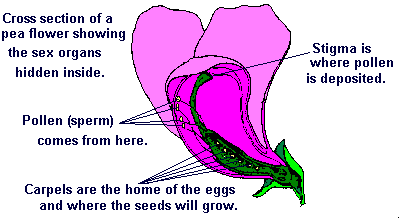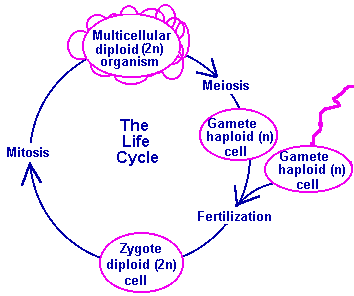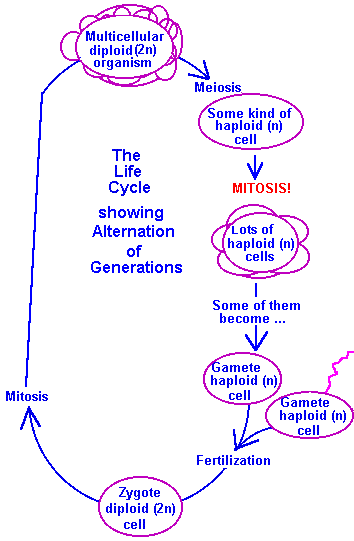
|
Teacher's Study Guide for Lesson Six
by Dr Jamie Love |
 |
 and
and  licensed under a Creative Commons Attribution-ShareAlike 4.0 International License.
licensed under a Creative Commons Attribution-ShareAlike 4.0 International License.

|
Teacher's Study Guide for Lesson Six
by Dr Jamie Love |
 |
Sexual reproduction is a cycle that alternates between haploid (n) and diploid (2n) cells. Meiosis is required for sexual reproduction. Unique zygotes are created.
Asexual reproduction does not alternate between haploid and diploid - it's mitosis all the way - and the offspring are clones (copies) of the parents.
|
Hermaphroditism is the coexistence of both male and female
sex organs, producing male and female gametes, in the same organism.
It's common among invertebrates and very common among plants (where it is called monoecious). Possible for some species of hermaphrodites (especially plants) to fertilize themselves in a process called "selfing". This is sexual reproduction! |

|
In order to self, the organism must first produce gametes. That requires meiosis - a "sign" for sexual reproduction.
Imagine that a plant with #1M and #1P could produces gametes with either #1M or #1P. It would produce thousands of these and it is possible that an egg carrying #1M could be fertilized with a pollen carrying #1M to produce a zygote that is #1M, 1#M.
Many plants can also reproduce asexually, sending out shoots or
runners that are simply extensions of themselves. These can break
away from the parent body and generate a new individual but that
individual will be an exact copy, a clone, of its parent. Cuttings
are clones of the parent.
There are no gametes. Only mitosis is involved. The "sign"
for asexual reproduction is the total lack of meiosis, gametes
or fertilization!
When animals reproduce asexually we call it parthenogenesis.
("Parthenos" is Greek for "virgin".) All-female-species
have no males in the population and reproduce asexually.
Dolly was created without meiosis, gametes or fertilization.
(This is a sign of what kind of reproduction?)
[Asexual.]
|
The life cycle is the span of the life of an organism from
the moment of fertilization to the time it reproduces.
To us, the haploid stage is merely a requirement to make a zygote. Our haploid cells, once created do "nothing". They just hang around waiting to fertilize something or be fertilized. Our diploid (2n) cells undergo mitosis but our haploid (n) cells never undergo mitosis. |

|
|
In some organisms the haploid (n) phase may undergo mitosis(!)
and these cells may make up a substantial portion of an organism
and its life cycle!
An organism that undergoes mitosis of its haploid cells is said to have alternation of generations. In fungi and mosses the haploid phase is quite prominent and each of these taxa has its own name for each part of their complex life cycle.
Many species of "primitive" plants use alternation of
generations during their life cycle but among vascular plants
the diploid (2n) phase dominates.
|

|
| Interphase | DNA and Centrosomes duplicate. | DNA and Centrosomes duplicate. | Centrosomes duplicate but DNA does not duplicate. |
|
|
|
| |
| Prophase | Chromosomes appear, centrioles migrate to opposite sides and grow spindles. | Same as mitosis plus homologous pairs synapse and crossing over occurs. | Just like mitosis.(Note that Telophase I may not have added much anyway.) |
| Prometaphase | Nuclear envelope breaks down and microtubules attach to twin kinetochores. "Tug-of-war" moves chromosomes back and forth. | Same as mitosis except only one kinetochore per chromosome. "Tug-of-war" is between tetrads formed by chiasmata linked dyads. | Like mitosis. (Note that there are two kinetochores on each chromosome.) |
| Metaphase | "Tug-of-war" ends in a "draw", with all dyads along the metaphase plate. | "Tug-of-war" ends in a "draw", with all tetrads along the metaphase plate. | Like mitosis except there are only half as many dyads at the metaphase plate. |
| Anaphase | Chromatids separate (chromatids become chromosomes) and migrate to opposite poles. | Chromosomes/dyads separate (chromosomes/dyads remain intact) and migrate to opposite poles. | Like mitosis. |
| Telophase | Chromosomes decondense and a nuclear envelope reforms. | Same as mitosis or it may not occur at all (depending on the species). | Like mitosis |
| Comments | One 2n nucleus became two 2n nuclei. This cell is 4n! (But not for long.) | One diploid nucleus became two haploid nuclei but this cell is still diploid until ... | Each haploid (1n) nucleus became two haploid nuclei. Cell is diploid until ... |
|
| Cell membrane divides cell and separates the two (2n) nuclei. | Cell membrane divides cell and separates the two (1n) nuclei. | Cell membrane divides cell and separates the two (1n) nuclei. |
| Comments | Now we have two cells that are diploid (2n). | Now we have two cells that are haploid (1n). | Now we have four cells that are haploid. |
| Final Comment |
One diploid mother cell produces two diploid daughter cells.
Note that chromatids become chromosomes so "n" does not change. Most cells/nuclei divide by mitosis.This is used for clones & asexual reproduction. |
One diploid mother cell produces two haploid daughter cells.
Prophase is very long due to all the crossing over. Anaphase I is the point of "reduction division". Chromosomes do not split (chromatids do not become chromosomes). Now go to top of next column! |
Two haploid (1n) cells became four haploid cells.
Note that chromatids become chromosomes so "n" does not change. Because meiosis II follows meiosis I, we often say (correctly) that meiosis turns one diploid nucleus into four haploid nuclei. |